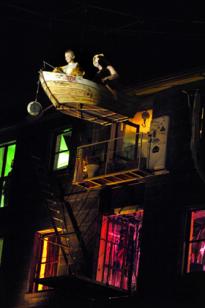 |
Dream Masons photo Michael Rayner |
The rigging is fantastic: ramps appear out of nowhere allowing performers to scale the building; a washing line strung between windows allows a performer to swing from one to another; and skilful wiring allows a fisherman to row in mid-air. Projections and shadow play reveal scenes and sub-plots further accentuated by the deftly changing music score as each window lights up.
Mood is largely dictated by the music and lighting, and most of the characters are defined by their musical accompaniment. The excellent small cabaret-style band, comprising tuba, drums, keyboard, bells and accordion, generate the ominous quality of a scene with a whale that would make Hollywood directors jealous. And many members of the audience cannot help but bop to the more upbeat music.
The building is populated with clown-like stereotypes: the helpless bourgeois lady in a wheelchair, the woman hanging out washing and yearningly holding up a wedding dress; the muscular sailor showing off his strength to a ditzy girl; and the ‘old hag’—a woman with a hunchback. The characters visit or intrude on each other or party—until the plumbing goes wrong. This is where the production comes to life. The building is flooded, resulting in an evacuation to the top storey providing suspense and interest so far lacking in the production. The water rises, fish and shadowy water demons and finally a giant whale appear, impressively filling the windows of the entire façade.
After the initial introduction to the building and its inhabitants, large banners had been unfurled to announce the five chapters of the story, revealing the production to be an allegory of the flooding of Lake Pedder. (Really! What did the first part of the production have to do with this?). For me Dream Masons relies a bit too heavily on glitzy stunts and theatrics, dated gender stereotypes and a trivialising of the Lake Pedder disaster to form a coherent and convincing story. However, the design, with its vertical staging and clever use of windows, rigging and lights was fantastic; so let’s hope that this approach is used again in the future in a more coherent production.
Dream Masons, story, design & theatrical concept Jim Lasko, Jessica Wilson, Joey Ruigrok Van Der Werven, directors Jessica Wilson and Jim Lasko, designers Joey Ruigrok Van Der Werven, Jim Lasko, musical director Basil Hogios, lighting designer Daniel Zika, creative producer Jessica Wilson, executive producer Kay Jamieson; Salamanca Arts Centre, Ten Days on the Island, March 23-26
Lucy Hawthorne is a Hobart based writer with a background in visual arts (sculpture, drawing, sound and installation art), music and dog obsession. She is a postgraduate studying art and design theory at the Tasmanian School of Art.
© Lucy Hawthorne; for permission to reproduce apply to [email protected]








 back
back